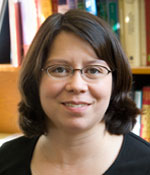Rachel Segalman
Biography:
 Rachel A. Segalman is an Associate Professor of Chemical Engineering at the University of California, Berkeley and an Associate Faculty Scientist in the Materials Science Division of Lawrence Berkeley National Laboratories. Segalman received her B.S. in Chemical Engineering with highest honors from the University of Texas at Austin. During the summers of 1993-96, she interned at Sandia National Laboratories (Albuquerque) and at the University of Texas. She then performed her doctoral work in Chemical Engineering (polymer physics) at the University of California, Santa Barbara in 1998-2002. Following her PhD, Segalman was a postdoctoral fellow at the Universite Louis Pasteur in Strasbourg France. She then joined the faculty of UC Berkeley in the spring of 2004 as the Charles Wilke Assistant Professor of Chemical Engineering. Segalman is the author of more than 40 publications including 3 invited reviews and one book chapter. She has been granted two patents and one more is pending. She is an Alfred P. Sloan Fellow and has received the Presidential Early Career Award for Science and Engineering (PECASE), MDV Innovators Award, TR35: Technology Review’s Top Innovators Under 35, Hellman Family Young Faculty Award, 3M Untenured Faculty Award, NSF CAREER Award, Intel Young Faculty Seed Award, and Chateaubriand Postdoctoral Fellowship. She is currently serving on the Science and Technology Committees for Los Alamos and Livermore National Laboratories and is an Associate Editor for the Annual Reviews of Chemical Engineering. Segalman is also an active member of APS, ACS, MRS, and AIChE and sits on the Executive Committee for the UC Berkeley Graduate Group in Applied Science and Technology. Her website address is: http://www.cchem.berkeley.edu/rasgrp/
Rachel A. Segalman is an Associate Professor of Chemical Engineering at the University of California, Berkeley and an Associate Faculty Scientist in the Materials Science Division of Lawrence Berkeley National Laboratories. Segalman received her B.S. in Chemical Engineering with highest honors from the University of Texas at Austin. During the summers of 1993-96, she interned at Sandia National Laboratories (Albuquerque) and at the University of Texas. She then performed her doctoral work in Chemical Engineering (polymer physics) at the University of California, Santa Barbara in 1998-2002. Following her PhD, Segalman was a postdoctoral fellow at the Universite Louis Pasteur in Strasbourg France. She then joined the faculty of UC Berkeley in the spring of 2004 as the Charles Wilke Assistant Professor of Chemical Engineering. Segalman is the author of more than 40 publications including 3 invited reviews and one book chapter. She has been granted two patents and one more is pending. She is an Alfred P. Sloan Fellow and has received the Presidential Early Career Award for Science and Engineering (PECASE), MDV Innovators Award, TR35: Technology Review’s Top Innovators Under 35, Hellman Family Young Faculty Award, 3M Untenured Faculty Award, NSF CAREER Award, Intel Young Faculty Seed Award, and Chateaubriand Postdoctoral Fellowship. She is currently serving on the Science and Technology Committees for Los Alamos and Livermore National Laboratories and is an Associate Editor for the Annual Reviews of Chemical Engineering. Segalman is also an active member of APS, ACS, MRS, and AIChE and sits on the Executive Committee for the UC Berkeley Graduate Group in Applied Science and Technology. Her website address is: http://www.cchem.berkeley.edu/rasgrp/
Statement:
My research lies at the intersection of materials chemistry, physics and technology, focusing on the fundamental processes that control structure at the nanometer lengthscale and then understanding how this structure affects properties. In particular, my group has focused on understanding structure property relationships in organic molecules for energy applications including photovoltaics, thermoelectrics, and fuel cells. I will bring to FIAP the experience of working at the intersection of fundamental and applied research simultaneously at an academic institution and a national laboratory. As FIAP member-at-large, I would work to help FIAP “take advantage of the evolving opportunities in the practice and application of physics” by fostering the participation of members from a variety of backgrounds and institutions.
